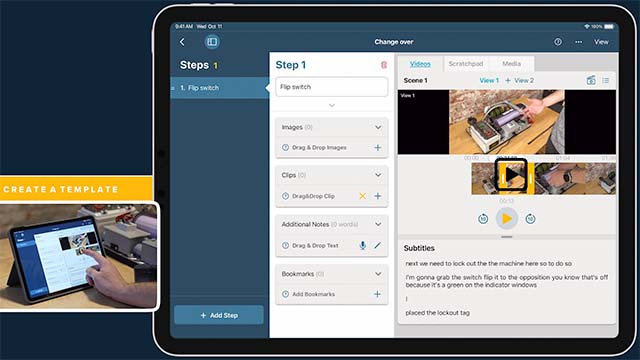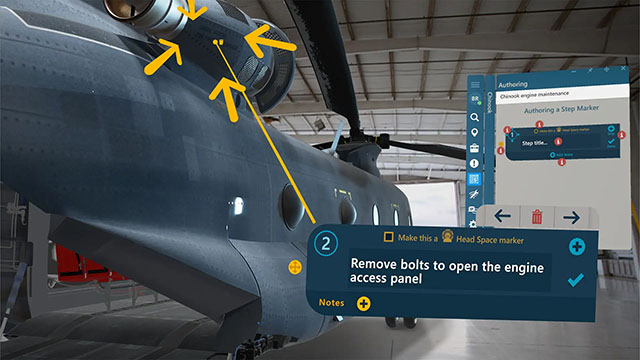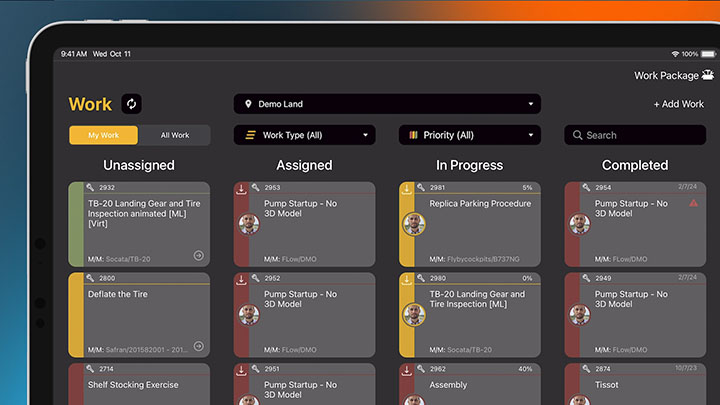Manifest 4.0 is here! And we are excited to share some of its details to help you prepare.
Manifest 4.0 introduces Orgs, a new data paradigm that provides organizations the ability to separate and control access to Manifest content within a single domain, while providing users a simplified view of only information relevant to them. Although use of this new feature is optional, the release will introduce some changes to the way Manifest data is managed that should be understood by all Administrators and Authors.
Read on to learn more.
Timeline
| Application | Release Date |
| Manifest Web Application v4.0 | Thursday, Oct 3rd |
| Manifest 3D for HoloLens 2 v4.0 | Thursday, Oct 3rd |
| Manifest iPadOS v4.0 | Thursday, Oct 3rd |
| Manifest for Docker, v.4.0.2 | Friday, Nov 8th |
Powerful new functionality in Manifest 4.0
Organize your content with Orgs
Orgs allows you to segment and manage Manifest content such as Asset Classes, Assets, Templates and Work. Within your Manifest domain, create an unlimited number of Orgs with up to 7 levels of hierarchy that allow you to segment and store content based on groups, teams, functions, roles, skill level, geography, or any other organizational designation. All content is associated to, stored within, and accessed from a specific Org.
Manage access to content with Orgs
Every user is assigned and associated with a specific Org or set of Orgs and only has access to content associated with these Orgs. This added flexibility provides new ways to secure, manage, simplify and view Manifest content – all within a single domain. Some examples include:
- Restrict new employee access to only training content until they are fully on-boarded
- Share access to site-specific equipment and procedures only with employees of that site
- Limit operators’ access to only the assets and procedures associated with equipment on which they are certified
Simplify and filter content views with Orgs
Manifest 4.0 provides new filtering capabilities that enable content to be viewed by specific Orgs. As a user, if you have only access to one Org, your views will be automatically simplified to see only the Manifest content for your Org. If you have access to multiple Orgs and child Orgs, you will encounter new filters in many areas of Manifest that will allow you to quickly simplify your views and focus on only the content that is relevant to your immediate tasks.
Three important Notes on Manifest 4.0
Simplify and filter content views with Orgs
Orgs provide a powerful new paradigm for organizing and managing your content and its accessibility. But if you prefer to keep all Manifest data in one place and accessible by everyone in your domain, they don’t need to be used. In fact, adding data to your domain will become even easier as we remove the requirement to create and assign Assets to Locations. If your Manifest domain would benefit from segmenting data and views for users, Orgs make this an easy thing to implement and will simplify the experience for your Operators.
Keep your eye on the Org
If you’re an existing user and are implementing Orgs, your views will change. It’s not complicated but be sure to be aware of your Org filter and keep track of where you are creating or viewing content as it is now Org-specific.
No Locations
That’s not exactly true. Locations still live on as a data field when creating and viewing Assets, but they are no longer required within the data hierarchy. If you want to organize your content and data by geography or physical location, Orgs will be the way to do that moving forward.
Support Questions
Updating to 4.0
Will I be automatically upgraded to Manifest 4.0?
For all hosted instances of Manifest, the Manifest Web Application will automatically update to version 4.0. Once released, clients are encouraged to ensure all Manifest 3D and iPadOS applications are upgraded immediately to ensure full compatibility.
If we are using an On-Premise (Manifest for Docker) server, how should we coordinate this update?
Clients using an On-Premise (Manifest for Docker) server should not update Manifest 3D or Manifest iPadOS applications to version 4.0 until their Docker instance is updated to a compatible version.
What changes can I expect when our Manifest instance is updated to v. 4.0?
For hosted and on-premise instances of Manifest, the following changes will occur after upgrading to Manifest 4.0:
- The introduction of Orgs – a new way to separate and manage your Manifest data
- A redesigned Connect interface
- Orgs replacing Locations as a way of separating Assets and Work. This change will result in the following updates in Manifest 4.0:
- Locations are no longer required to create Assets
- Work will no longer use Locations to filter and view Jobs and Tasks
- The Locations menu option will be removed from all Manifest applications
- The Security Admin role will be updated to have access ONLY to User Management and Logs
- Minor design changes to streamline the Manifest Web menu navigation
What can I expect if I do not update the Manifest 3D or Manifest iPadOS application(s) to v. 4.0?
Manifest 3D and Manifest iPadOS application(s) running v. 3.1 or earlier will encounter various compatibility issues due to the changes introduced by 4.0. While many views and features may continue to work without updating, clients should update all Manifest applications to 4.0 upon release to ensure application and data stability.
Org Support
We do not need to use Orgs; is there an option to turn this off?
Orgs is an optional feature. If a domain is not utilizing Orgs, there will be very little difference to Manifest users. Only once a new Org is created will this feature be enabled for all users in your domain.
We would like to start segmenting our data using Orgs. How should we plan on organizing our Orgs?
First, it will be important to understand which roles can create Orgs, add users, create or add content to an Org, and who can view content in any Orgs created in your domain. This will help you consider the best way to manage your set-up, content, and access.
- Enabling Orgs: Only Admin users can create Orgs, and thereby “turn on” Orgs for your domain. To enable Orgs, an Admin will navigate to the Orgs page in the Menu and create the first new Org. Creating an Org requires only an Org Name and Description. This action will immediately update the domain interface to reflect this feature on all Manifest applications.
- Root Org: Once the first new Org is created, it will become a Child Org under the “root” level Org named Root (this name can be edited). By default, all users and existing Manifest data will live in the root Org until data is moved to a Child Org(s).
- Org hierarchy: The Root Org can have an unlimited amount of Child Orgs, and there can be up to 7 levels in the hierarchy (including the Root). Users will automatically have access to any Child Orgs of an Org they are assigned, so clients trying to simplify or limit access to Manifest data should consider limiting views by creating separate Org branches by function / area or assigning Users to lower-level Orgs.
- Organizing Manifest data by Org: Asset Classes will be shared (not duplicated) when added to more than one Org. This means that any Org with access to a specific Asset Class will be able to view and edit this content – including 3D Models, Documents, Meters, and Templates. Assets may only be assigned to one Org, and all associated Jobs, Tasks, Faults, and Meter Measurements will only be viewable in the assigned Org.
- Managing User Org Access: Only Security Admins can create Users, provision a Manifest License, assign Manifest Roles, and add Users to Orgs. Once an Admin has created the domain Orgs and segmented Manifest content accordingly, the Security Admin may add Users and/or assign them to the appropriate Org(s). Remember that Users will automatically inherit access to any Child Orgs to the one they are assigned.
Our team is happy to consult with you to evaluate your segmentation and access goals so you can coordinate with this update and begin leveraging Orgs as quickly as possible.
What will change for our domain and users if we set up Orgs?
Once Orgs are enabled, users assigned to multiple Orgs will be prompted at first login to select the Org they are working in, and the application will load only data associated with that Org. An Org selector will allow users to switch Orgs at any time but only content for the selected Org will display throughout the application – simplifying the view and experience for all users.
The following areas within the application will also reflect the use of or be affected by Orgs:
- Adding Users: Users will need to be assigned to at least one Org
- Adding Asset Classes: Admins and Authors will have the option to select existing Asset Classes from other Orgs to add to new Orgs.
- Connect: Users will see all domain Contacts but be able to filter by Orgs. If a Contact sends or receives an Org specific Connect Message (e.g. Team Job Invite or Job Reassignment), these alerts will list the associated Org.
- Importing Manifest Packages: Importing Templates and associated Asset Classes from other domains will now be restricted to only root level Admins and Authors. These Users will be able to import to the domain and associate with all relevant Orgs.
Our domain will not use Orgs. Will we be impacted by this 4.0 update?
A key change with 4.0 is that Orgs will replace Locations as a way of separating Assets and Work. This change will result in the following updates in Manifest 4.0:
- Locations are no longer required to create Assets. Location will be an optional data field.
- Work will no longer use Locations to filter and view Jobs and Tasks
- The Locations menu option will be removed from all Manifest applications
- If a domain is not using Orgs, all Assets will live at the domain level. If Assets should be separated by Location, Orgs is recommended as a new method of organizing Assets.
If Orgs is replacing Locations, what will happen to the Location data in our domain when Manifest updates to 4.0?
Any Assets created prior to 4.0 will still have the Location associated and displayed along with all Asset data. Newly created Assets in 4.0 onward will have an optional Location dropdown populated by any previously created Locations with the ability to add, edit, and delete Locations.
What if we change our minds and want to turn off Orgs for our domain?
Admins can delete Orgs if there is no content or Child Orgs associated. To disable Orgs in the domain, Admins will simply need to move all Manifest content to the root Org and delete Child Orgs.




